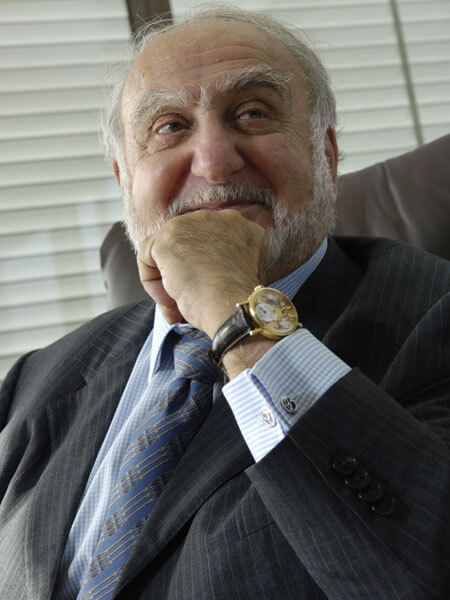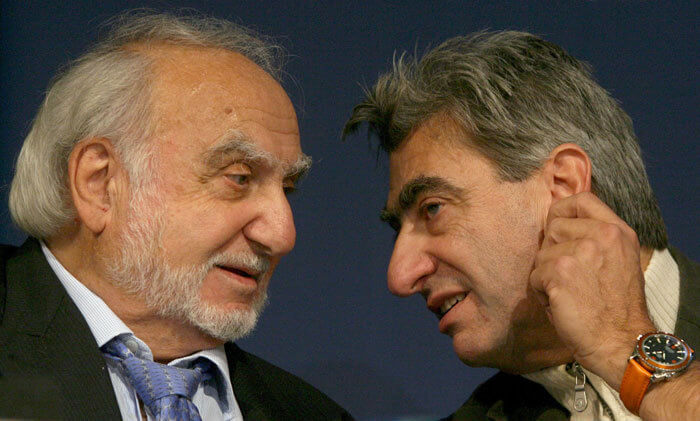On Monday 28th June, 2010, Nicolas G. Hayek died of heart failure in his office. He was 82. This inveterate entrepreneur and staunch advocate of innovation, a man known as much for his exceptional marketing skills as for his outbursts against the Swiss National Bank, politicians and financial analysts, leaves behind the memory of a great captain of industry and a worthy heir to the nineteenth century’s pioneers. This self-styled “living legend” was outspoken in his belief that “modesty is hypocrisy for the successful.” Clearly Nicolas Hayek ranked among them, having pulled Swiss watchmaking back from the brink. This was no easy feat. In the late 1970s, the Swiss watch industry was floundering, having missed the quartz boat. The country’s specialists mastered quartz technology – the Centre Électronique Horloger in Neuchâtel made the first electronic wristwatch as early as 1967 – but the profession was unconvinced, opening the floodgates for Japanese brands and relegating fine mechanical timepieces to the rank of vintage curio in the process.
In the darkest days of the early 1980s, the industry was threatened with out-and-out bankruptcy, losing a million Swiss francs a day, seven days a week. Banks were about to pull the plug on the industry’s two giants, Société Suisse pour l’Industrie Horlogère (SSIH, formed after the merger of Tissot and Omega in 1930) and Société Générale Horlogère Suisse (ASUAG, set up in 1931 and owner of Rado, Longines and ETA Ebauches), which together were losing close to half a billion Swiss francs a year.
On the wings of Swatch
Born in 1928 in Beirut, Swiss by adoption and head of his own consultancy firm, Nicolas Hayek was called to the rescue. However, his prescription was so unorthodox that bankers could find no one to put it into practice. Hayek recommended merging the two companies that still had some value, namely SSIH and ASUAG, and, more importantly, counter-attacking from the bottom end of the market to stop the Japanese in their tracks. The problem being that no one really believed anything could be done, except Hayek himself who offered to lead the offensive, provided he had control of operations through a shareholder pact. In his words: “To think that some banks wanted to sell the assets of ASUAG and SSIH, Swatch Group’s ancestors. We’re talking about enormous assets. Their idea was to sell to the Japanese because we’d convinced ourselves the Swiss were incapable of producing anything any more, and that the future lay in services. I felt sick just hearing them. I told them there were 200 million francs of potential profit. I don’t blame them. It was hard to believe, after all. Which is why they sold me 51% of the company.”
Nicolas Hayek developed a company that now stands head and shoulders above the rest of the global watch industry.
The rest of the story is well-known, being so intimately linked to the Swatch watch’s success. The cost of producing a Swatch still peaks at around CHF 8, after 27 years and more than 400 million watches sold. This first ever disposable watch was an overnight sensation and revolutionised how timepieces were worn. Its success has never waned, thanks to the marketing genius of Hayek himself. Building on a breakthrough yet to be matched in the industry, against all odds Nicolas Hayek developed a company that now stands head and shoulders above the rest of the global watch industry.
Complete control of production
It’s an undisputed fact: with its 24,000 employees, 160 factories, 100 affiliated companies and gross sales of CHF 5.4 billion in 2009 – probably over CHF 6 billion this year – Swatch Group is the only watchmaker in the world to master every stage of production. The Group has the resources to manufacture and assemble every component in timepieces which it markets under 19 different brands, with no limitations on volume. It is, quite simply, an enormous manufacturing entity rolled into one, producing not just for the Swatch and Flik Flak brands but also and above all for the prestigious names in its portfolio – Blancpain, Breguet, Glasshütte Original, Jaquet Droz, Léon Hatot and Omega – operating at the high end of the market, a segment which has grown in importance for the group over recent years. Not forgetting Certina, Hamilton, Longines, Rado and Tissot.
Nicolas Hayek had numerous masterstrokes to his name. By acquiring first Blancpain then Breguet in the 1990s, the Biel-based group not only added two prestigious brands to its stable at a still reasonable price, it picked up a couple of manufacturing gems along the way, namely Frédéric Piguet and Nouvelle Lémania. They added to the industrial capacity of Valjoux and ETA, the main piece in the puzzle with annual production of 75 million quartz and mechanical movements. Industry observers estimate that the Swatch Group represents 20% to 30% of worldwide production of watch movements and parts. In other words, it is virtually impossible to manufacture a watch in Switzerland today without going through the group, which is controlled by the Hayek family.
Committed to renewable energy
The Swatch Group, under Nicolas G. Hayek’s impetus, was also an early advocate, in the 1990s, of hybrid, thermal and rechargeable electric engines. This technology took the form of the Swatchmobile which spawned Mercedes’ Smart, minus the original hybrid concept. The multinational is also active in electronic parts and systems, with clients in the automotive industry, consumer electronics and industrial electronics. More recently, again under Hayek’s leadership, the Group has taken its interest in clean and renewable energies a stage further and set up Belenos Clean Power, with Deutsche Bank and George Clooney as partners. The company develops solar and hydrogen fuel cells for decentralised energy production. One of its first applications is the Solar Impulse project which the group partners through its Omega brand. It aims to have an airplane take off and fly autonomously, day and night, around the world, propelled only by solar energy, without fuel or pollution. Solar Impulse’s first night flight is scheduled for around the summer solstice.
Nicolas Hayek didn’t live to witness this maiden voyage but he did ensure that the group would continue after him. His shareholder pool controls 41% of voting rights in the Swatch Group and, over the years, he brought various family members into the company fold, to the extent that observers now refer to the Hayeks as a watchmaking dynasty. Son Nick Hayek, 55, was appointed President of the Executive Group Management Board in 2003. Daughter Nayla is Vice-Chairman of the Board of Directors, and grandson Marc-Alexandre is a member of the Executive Group Management Board and CEO of Blancpain. In less than two decades, and working from the ground up, Nicolas Hayek engineered an extremely healthy watch group with equity equal to 78% of total assets and cash assets of some CHF 1.1 billion. Nicolas G. Hayek claimed the sun never set on the empire he built. Today, the court of watchmaking pays homage to its king.











